Human Resources: Exploring Values & Contributions to Success
VerifiedAdded on 2023/06/05
|15
|1729
|300
Report
AI Summary
This report examines the critical role of Human Resources (HR) in contributing to organisational success, focusing on change management theories and models, including Lewin's and Kotter's frameworks. It discusses the responsibilities of HR in managing change, such as providing training, embracing technology, and crafting strategies and policies. The report analyses different types of changes, including transformational and psychological changes, and their impact on employees and organisational stability. It also evaluates the complex relationship between organisational design and change management, using examples from manufacturing organisations. The report concludes with recommendations for effectively implementing changes, emphasising the importance of advancing employees and budgeting for successful transformations. This resource is available for students seeking past papers and solved assignments on Desklib.
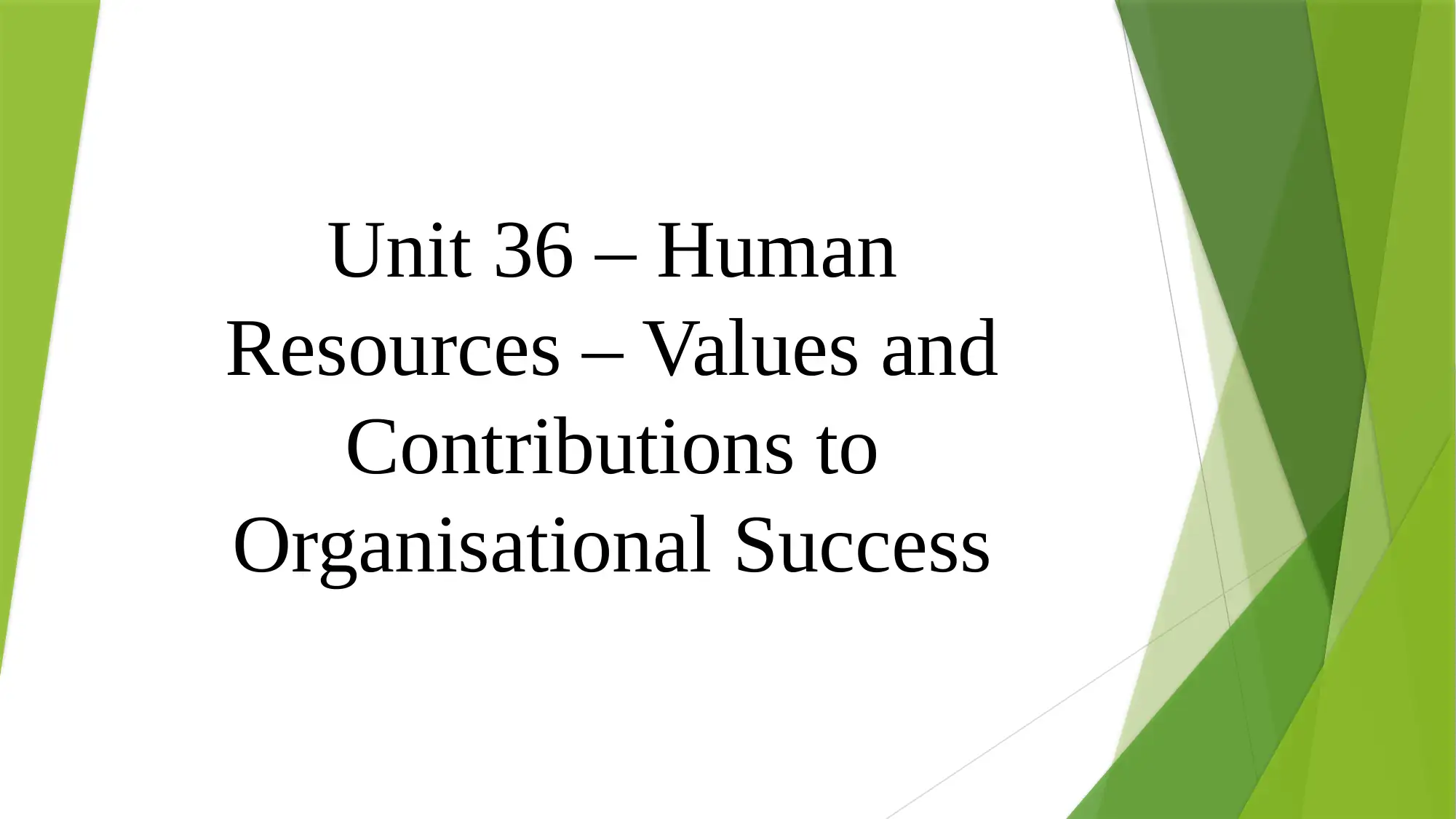
Unit 36 – Human
Resources – Values and
Contributions to
Organisational Success
Resources – Values and
Contributions to
Organisational Success
Paraphrase This Document
Need a fresh take? Get an instant paraphrase of this document with our AI Paraphraser
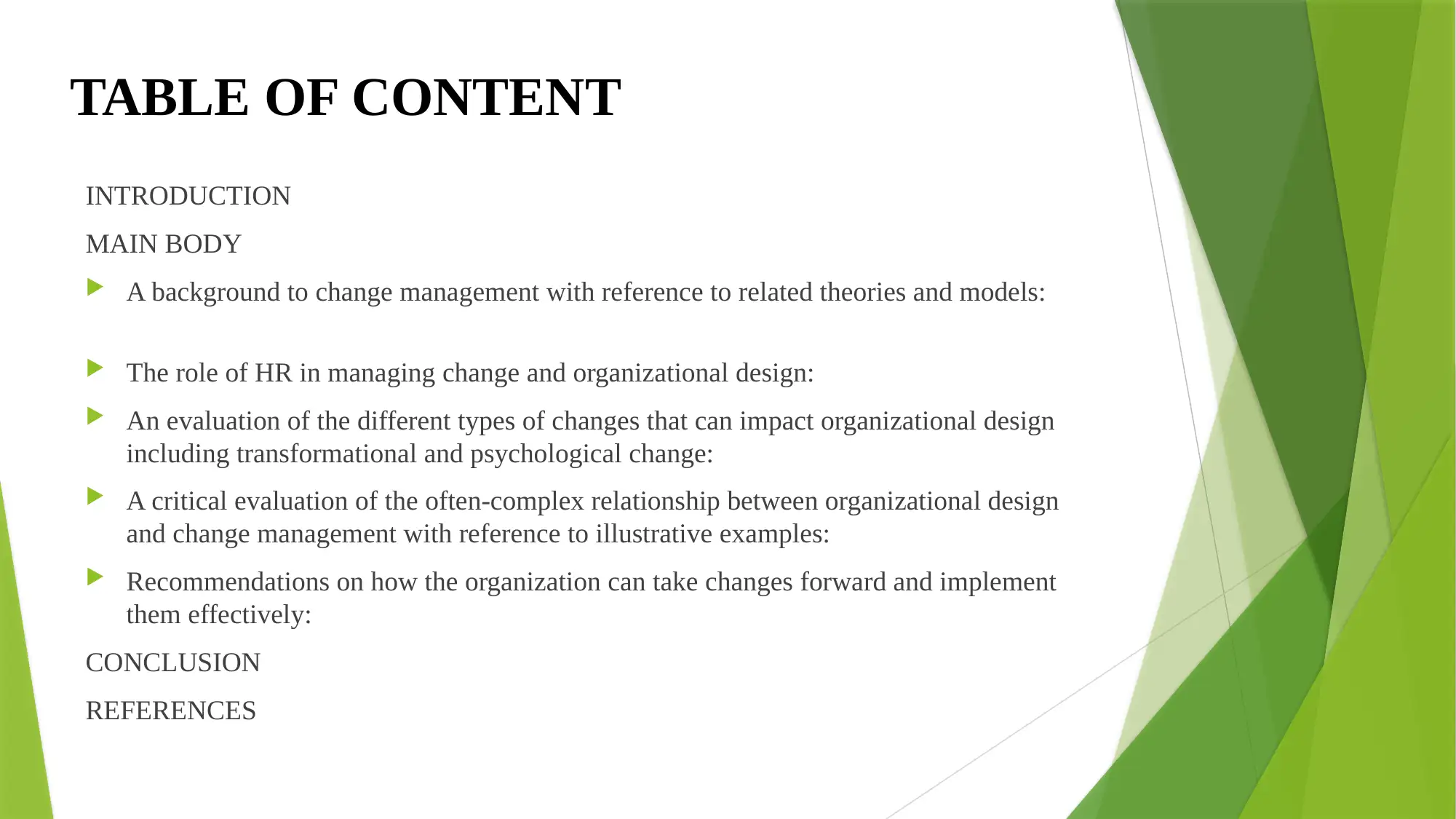
TABLE OF CONTENT
INTRODUCTION
MAIN BODY
A background to change management with reference to related theories and models:
The role of HR in managing change and organizational design:
An evaluation of the different types of changes that can impact organizational design
including transformational and psychological change:
A critical evaluation of the often-complex relationship between organizational design
and change management with reference to illustrative examples:
Recommendations on how the organization can take changes forward and implement
them effectively:
CONCLUSION
REFERENCES
INTRODUCTION
MAIN BODY
A background to change management with reference to related theories and models:
The role of HR in managing change and organizational design:
An evaluation of the different types of changes that can impact organizational design
including transformational and psychological change:
A critical evaluation of the often-complex relationship between organizational design
and change management with reference to illustrative examples:
Recommendations on how the organization can take changes forward and implement
them effectively:
CONCLUSION
REFERENCES

INTRODUCTION
Change is one of the most common but important process in the business organization
leading betterment in the workplace, adopting change become necessary at certain
point where firm demand improvement in the work, employee and environment.
This study is based on Tesco, one of the leading retailer in the world with ability to
adopt change.
This report will discuss change management theories and model including role of HR
in managing change.
Later, this report will discuss different types of change including transformational and
psychological.
At last, this report will discuss often-complex relationship between organizational
change management process.
Change is one of the most common but important process in the business organization
leading betterment in the workplace, adopting change become necessary at certain
point where firm demand improvement in the work, employee and environment.
This study is based on Tesco, one of the leading retailer in the world with ability to
adopt change.
This report will discuss change management theories and model including role of HR
in managing change.
Later, this report will discuss different types of change including transformational and
psychological.
At last, this report will discuss often-complex relationship between organizational
change management process.
You're viewing a preview
Unlock full access by subscribing today!

CHANGE MANAGEMENT THEORIES AND
MODELS:
Change management is complex process, firm face certain type of challenges during
change.
Every business organization have to adopt change for betterment of the workplace and
employee, these changes are necessary in the process.
Tesco need to adopt change management theories and models to manage change in the
workplace, there are certain theories and valuable model for the same, these are:
Lewin's change management model: This is one of the most common but important
model available for adopting change with effective process.
Developed by Kurt Lewin's change management model consist of three important
phases during change, Tesco need to adopt and need to craft strategies during three-
phase, these are:
MODELS:
Change management is complex process, firm face certain type of challenges during
change.
Every business organization have to adopt change for betterment of the workplace and
employee, these changes are necessary in the process.
Tesco need to adopt change management theories and models to manage change in the
workplace, there are certain theories and valuable model for the same, these are:
Lewin's change management model: This is one of the most common but important
model available for adopting change with effective process.
Developed by Kurt Lewin's change management model consist of three important
phases during change, Tesco need to adopt and need to craft strategies during three-
phase, these are:
Paraphrase This Document
Need a fresh take? Get an instant paraphrase of this document with our AI Paraphraser
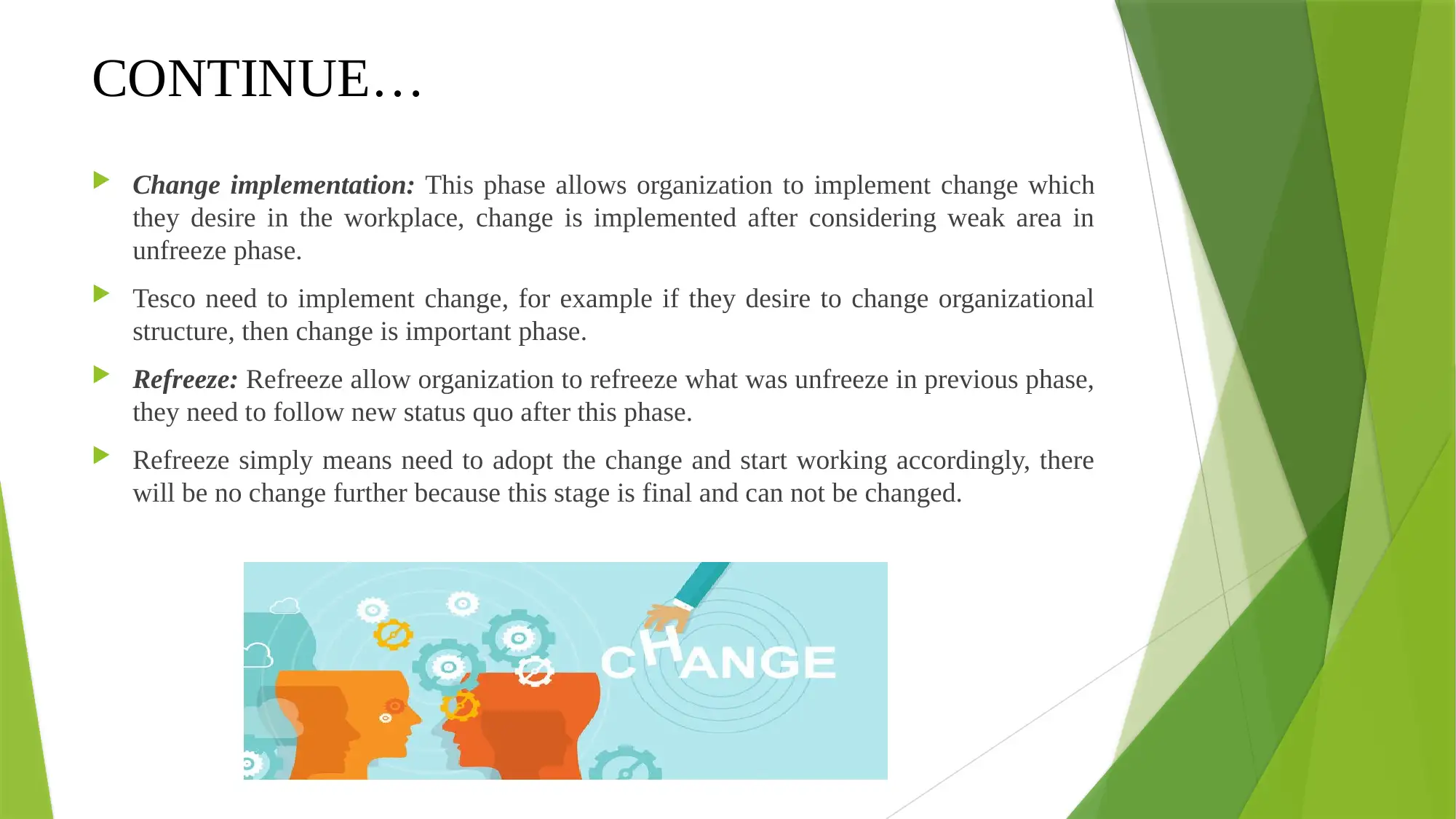
CONTINUE…
Change implementation: This phase allows organization to implement change which
they desire in the workplace, change is implemented after considering weak area in
unfreeze phase.
Tesco need to implement change, for example if they desire to change organizational
structure, then change is important phase.
Refreeze: Refreeze allow organization to refreeze what was unfreeze in previous phase,
they need to follow new status quo after this phase.
Refreeze simply means need to adopt the change and start working accordingly, there
will be no change further because this stage is final and can not be changed.
Change implementation: This phase allows organization to implement change which
they desire in the workplace, change is implemented after considering weak area in
unfreeze phase.
Tesco need to implement change, for example if they desire to change organizational
structure, then change is important phase.
Refreeze: Refreeze allow organization to refreeze what was unfreeze in previous phase,
they need to follow new status quo after this phase.
Refreeze simply means need to adopt the change and start working accordingly, there
will be no change further because this stage is final and can not be changed.

KOTTER CHANGE MANAGEMENT
THEORY:
Kotter change management theory: Kottter change management theory is one of the
best theory adopted by almost every organization to bring major change in their
organization and structure.
This theory allow organization to consider internal strength and improvement
according to the change and needs, Kotter argue that organization fail to complete their
project because they celebrate winning too early.
Change is slow process and take time to be completely implemented, kotter theory
include 7 steps to lead change in the workplace.
THEORY:
Kotter change management theory: Kottter change management theory is one of the
best theory adopted by almost every organization to bring major change in their
organization and structure.
This theory allow organization to consider internal strength and improvement
according to the change and needs, Kotter argue that organization fail to complete their
project because they celebrate winning too early.
Change is slow process and take time to be completely implemented, kotter theory
include 7 steps to lead change in the workplace.
You're viewing a preview
Unlock full access by subscribing today!
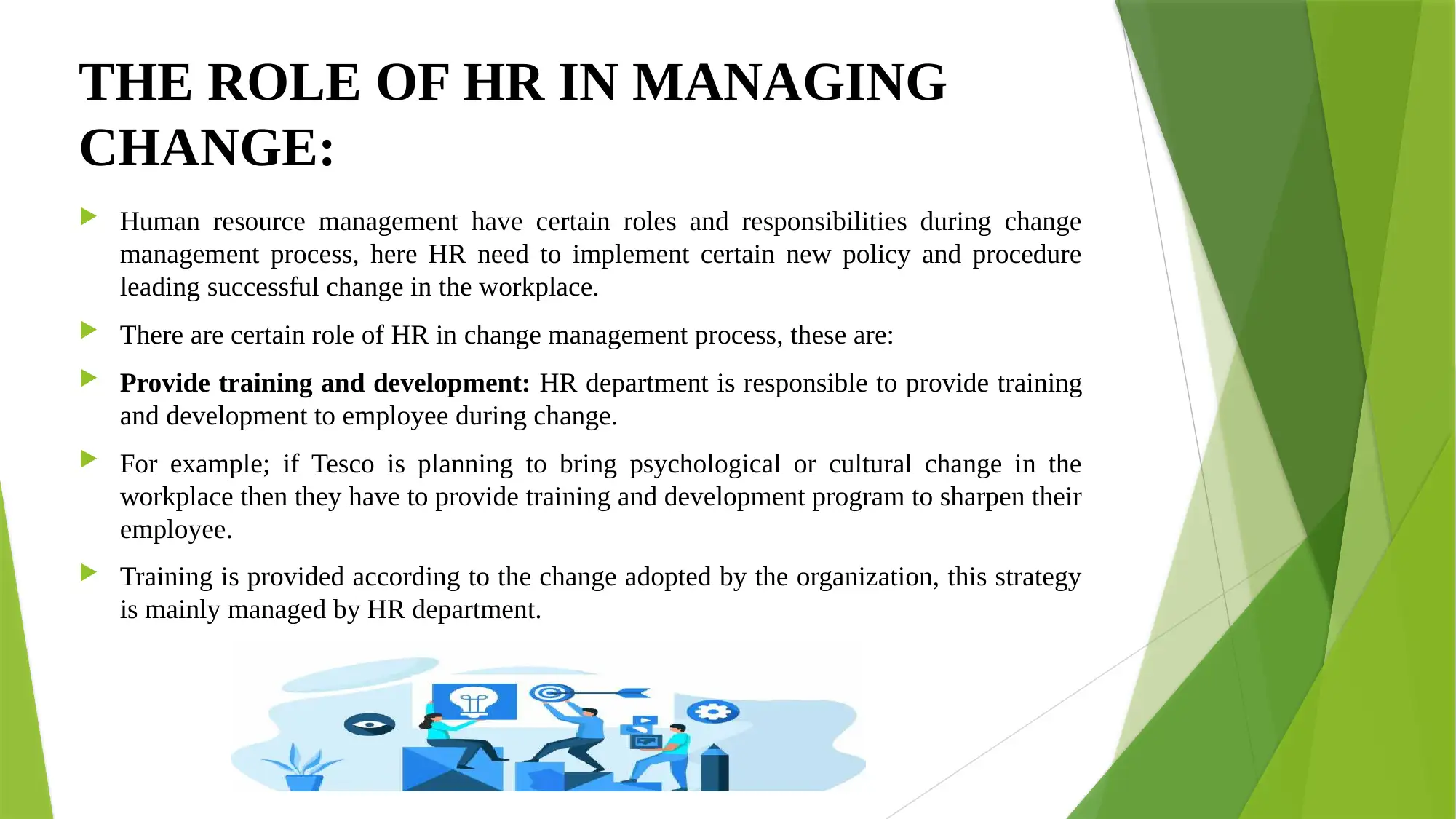
THE ROLE OF HR IN MANAGING
CHANGE:
Human resource management have certain roles and responsibilities during change
management process, here HR need to implement certain new policy and procedure
leading successful change in the workplace.
There are certain role of HR in change management process, these are:
Provide training and development: HR department is responsible to provide training
and development to employee during change.
For example; if Tesco is planning to bring psychological or cultural change in the
workplace then they have to provide training and development program to sharpen their
employee.
Training is provided according to the change adopted by the organization, this strategy
is mainly managed by HR department.
CHANGE:
Human resource management have certain roles and responsibilities during change
management process, here HR need to implement certain new policy and procedure
leading successful change in the workplace.
There are certain role of HR in change management process, these are:
Provide training and development: HR department is responsible to provide training
and development to employee during change.
For example; if Tesco is planning to bring psychological or cultural change in the
workplace then they have to provide training and development program to sharpen their
employee.
Training is provided according to the change adopted by the organization, this strategy
is mainly managed by HR department.
Paraphrase This Document
Need a fresh take? Get an instant paraphrase of this document with our AI Paraphraser
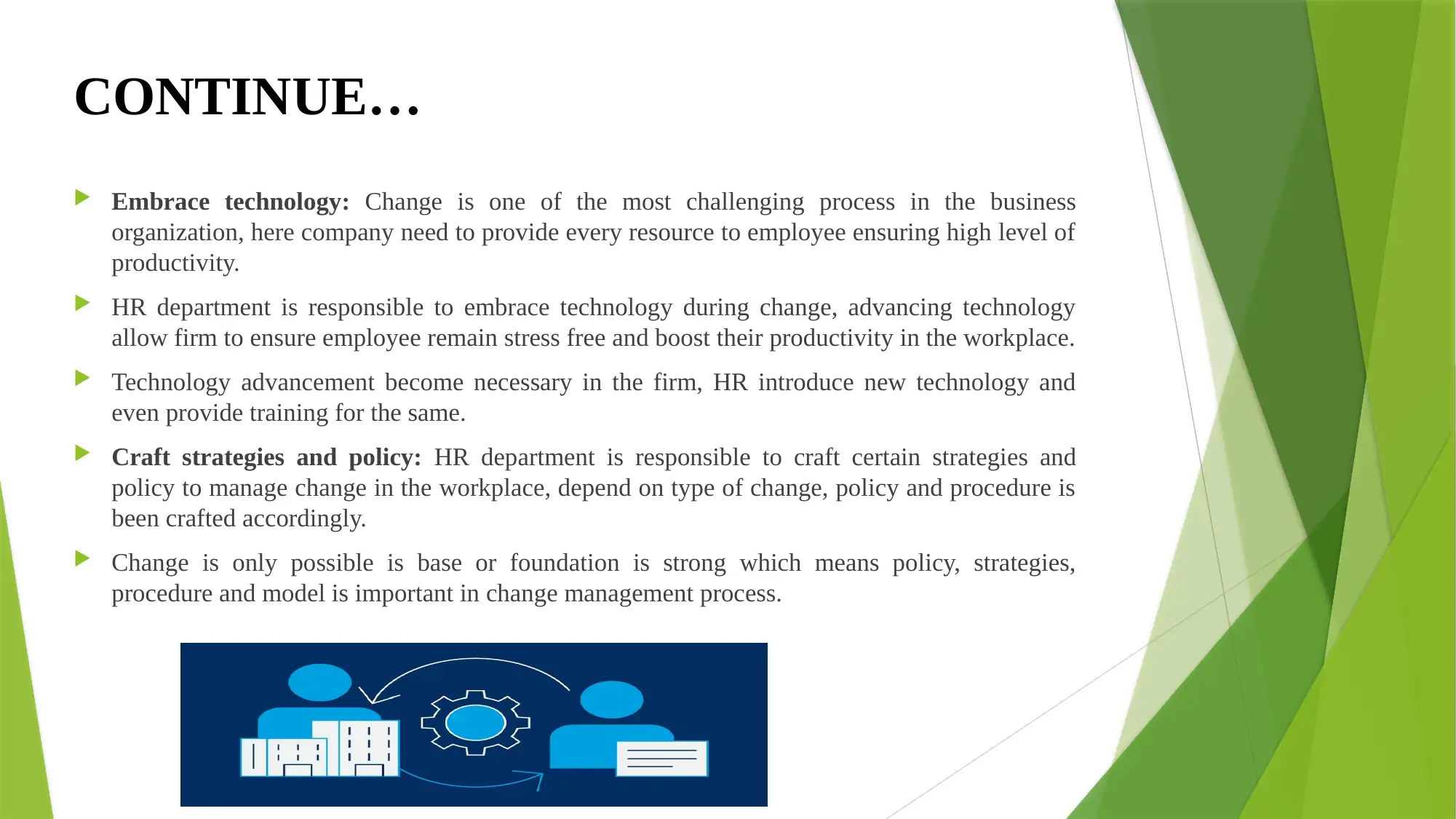
CONTINUE…
Embrace technology: Change is one of the most challenging process in the business
organization, here company need to provide every resource to employee ensuring high level of
productivity.
HR department is responsible to embrace technology during change, advancing technology
allow firm to ensure employee remain stress free and boost their productivity in the workplace.
Technology advancement become necessary in the firm, HR introduce new technology and
even provide training for the same.
Craft strategies and policy: HR department is responsible to craft certain strategies and
policy to manage change in the workplace, depend on type of change, policy and procedure is
been crafted accordingly.
Change is only possible is base or foundation is strong which means policy, strategies,
procedure and model is important in change management process.
Embrace technology: Change is one of the most challenging process in the business
organization, here company need to provide every resource to employee ensuring high level of
productivity.
HR department is responsible to embrace technology during change, advancing technology
allow firm to ensure employee remain stress free and boost their productivity in the workplace.
Technology advancement become necessary in the firm, HR introduce new technology and
even provide training for the same.
Craft strategies and policy: HR department is responsible to craft certain strategies and
policy to manage change in the workplace, depend on type of change, policy and procedure is
been crafted accordingly.
Change is only possible is base or foundation is strong which means policy, strategies,
procedure and model is important in change management process.
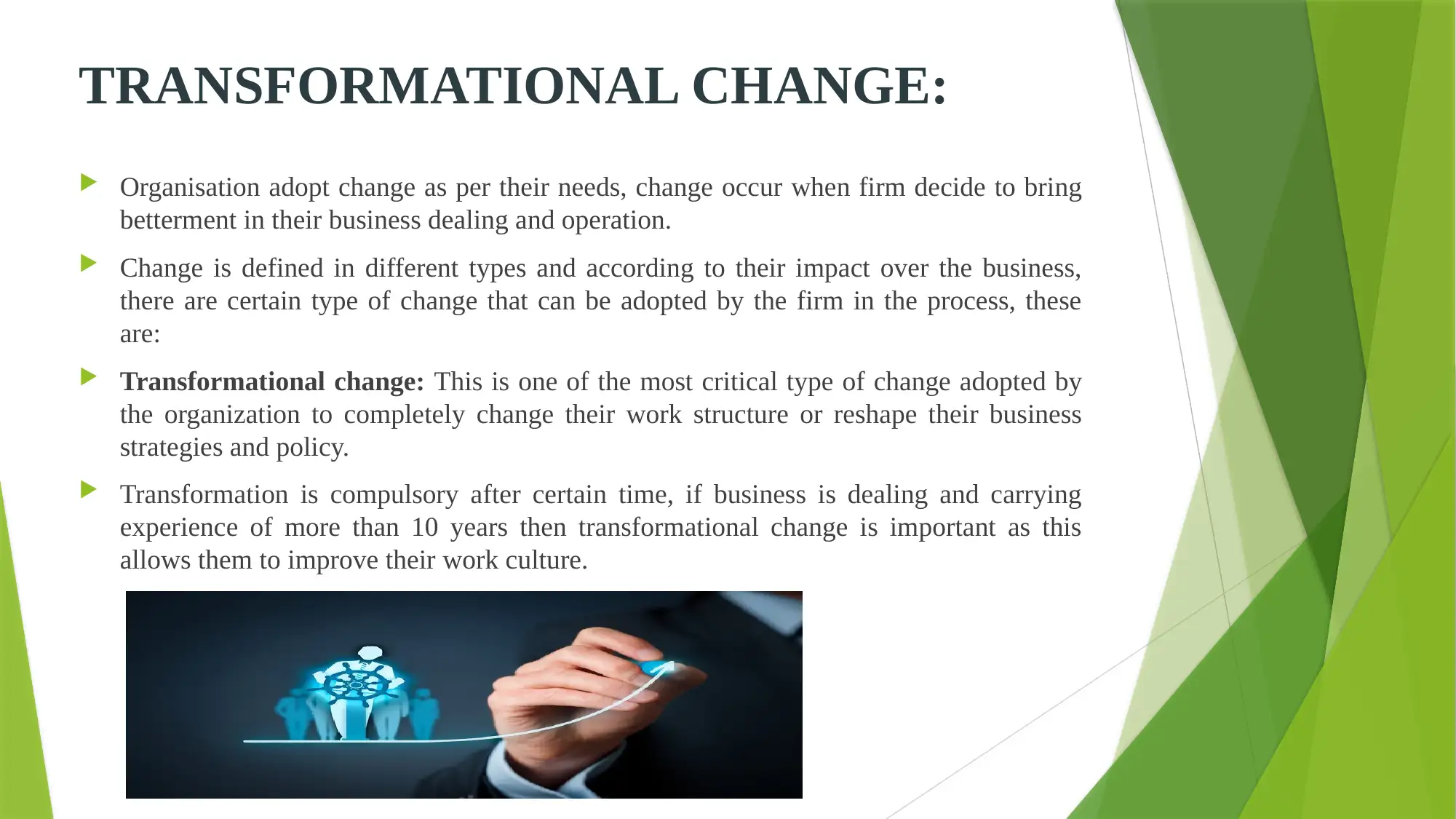
TRANSFORMATIONAL CHANGE:
Organisation adopt change as per their needs, change occur when firm decide to bring
betterment in their business dealing and operation.
Change is defined in different types and according to their impact over the business,
there are certain type of change that can be adopted by the firm in the process, these
are:
Transformational change: This is one of the most critical type of change adopted by
the organization to completely change their work structure or reshape their business
strategies and policy.
Transformation is compulsory after certain time, if business is dealing and carrying
experience of more than 10 years then transformational change is important as this
allows them to improve their work culture.
Organisation adopt change as per their needs, change occur when firm decide to bring
betterment in their business dealing and operation.
Change is defined in different types and according to their impact over the business,
there are certain type of change that can be adopted by the firm in the process, these
are:
Transformational change: This is one of the most critical type of change adopted by
the organization to completely change their work structure or reshape their business
strategies and policy.
Transformation is compulsory after certain time, if business is dealing and carrying
experience of more than 10 years then transformational change is important as this
allows them to improve their work culture.
You're viewing a preview
Unlock full access by subscribing today!
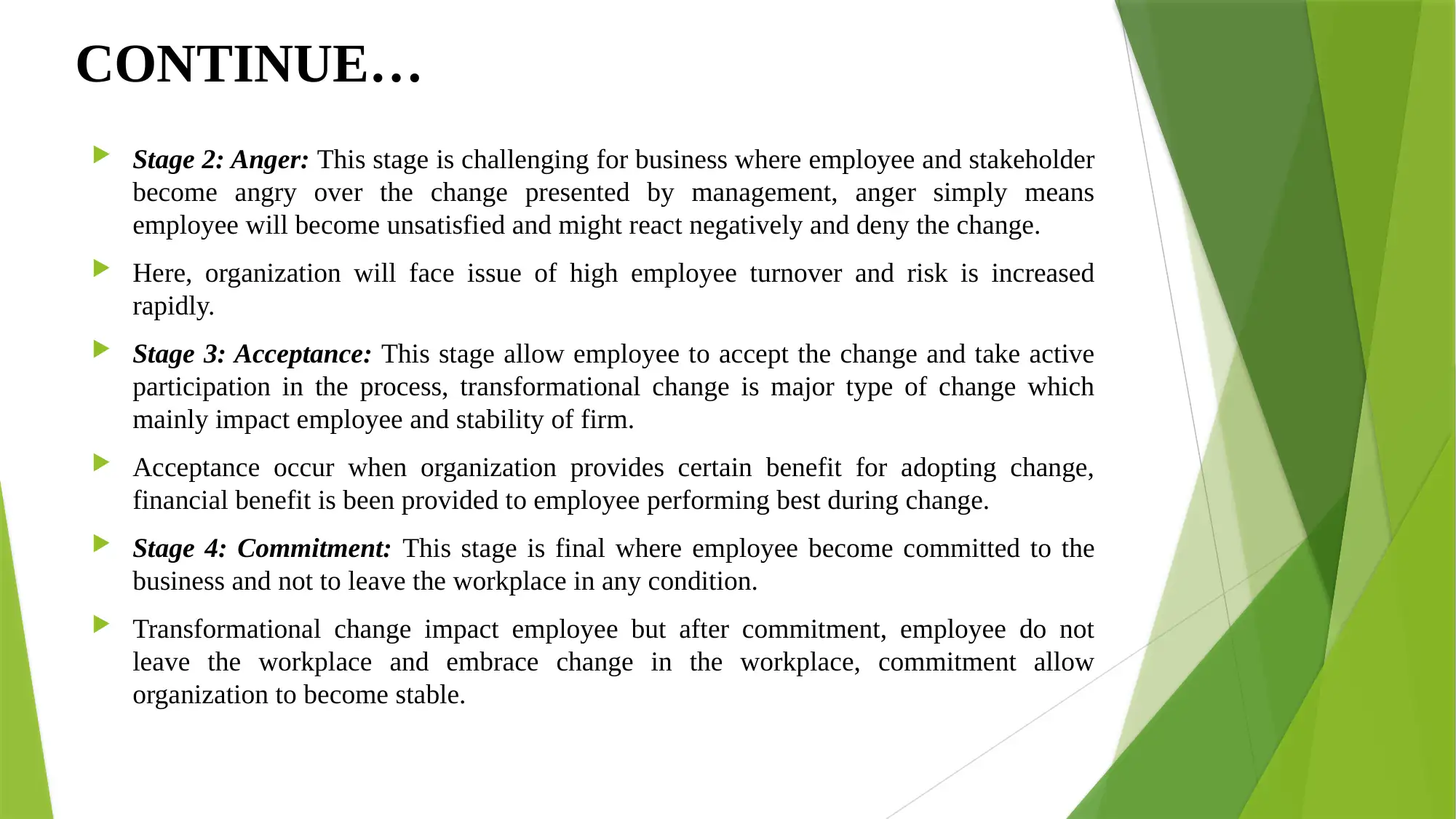
CONTINUE…
Stage 2: Anger: This stage is challenging for business where employee and stakeholder
become angry over the change presented by management, anger simply means
employee will become unsatisfied and might react negatively and deny the change.
Here, organization will face issue of high employee turnover and risk is increased
rapidly.
Stage 3: Acceptance: This stage allow employee to accept the change and take active
participation in the process, transformational change is major type of change which
mainly impact employee and stability of firm.
Acceptance occur when organization provides certain benefit for adopting change,
financial benefit is been provided to employee performing best during change.
Stage 4: Commitment: This stage is final where employee become committed to the
business and not to leave the workplace in any condition.
Transformational change impact employee but after commitment, employee do not
leave the workplace and embrace change in the workplace, commitment allow
organization to become stable.
Stage 2: Anger: This stage is challenging for business where employee and stakeholder
become angry over the change presented by management, anger simply means
employee will become unsatisfied and might react negatively and deny the change.
Here, organization will face issue of high employee turnover and risk is increased
rapidly.
Stage 3: Acceptance: This stage allow employee to accept the change and take active
participation in the process, transformational change is major type of change which
mainly impact employee and stability of firm.
Acceptance occur when organization provides certain benefit for adopting change,
financial benefit is been provided to employee performing best during change.
Stage 4: Commitment: This stage is final where employee become committed to the
business and not to leave the workplace in any condition.
Transformational change impact employee but after commitment, employee do not
leave the workplace and embrace change in the workplace, commitment allow
organization to become stable.
Paraphrase This Document
Need a fresh take? Get an instant paraphrase of this document with our AI Paraphraser
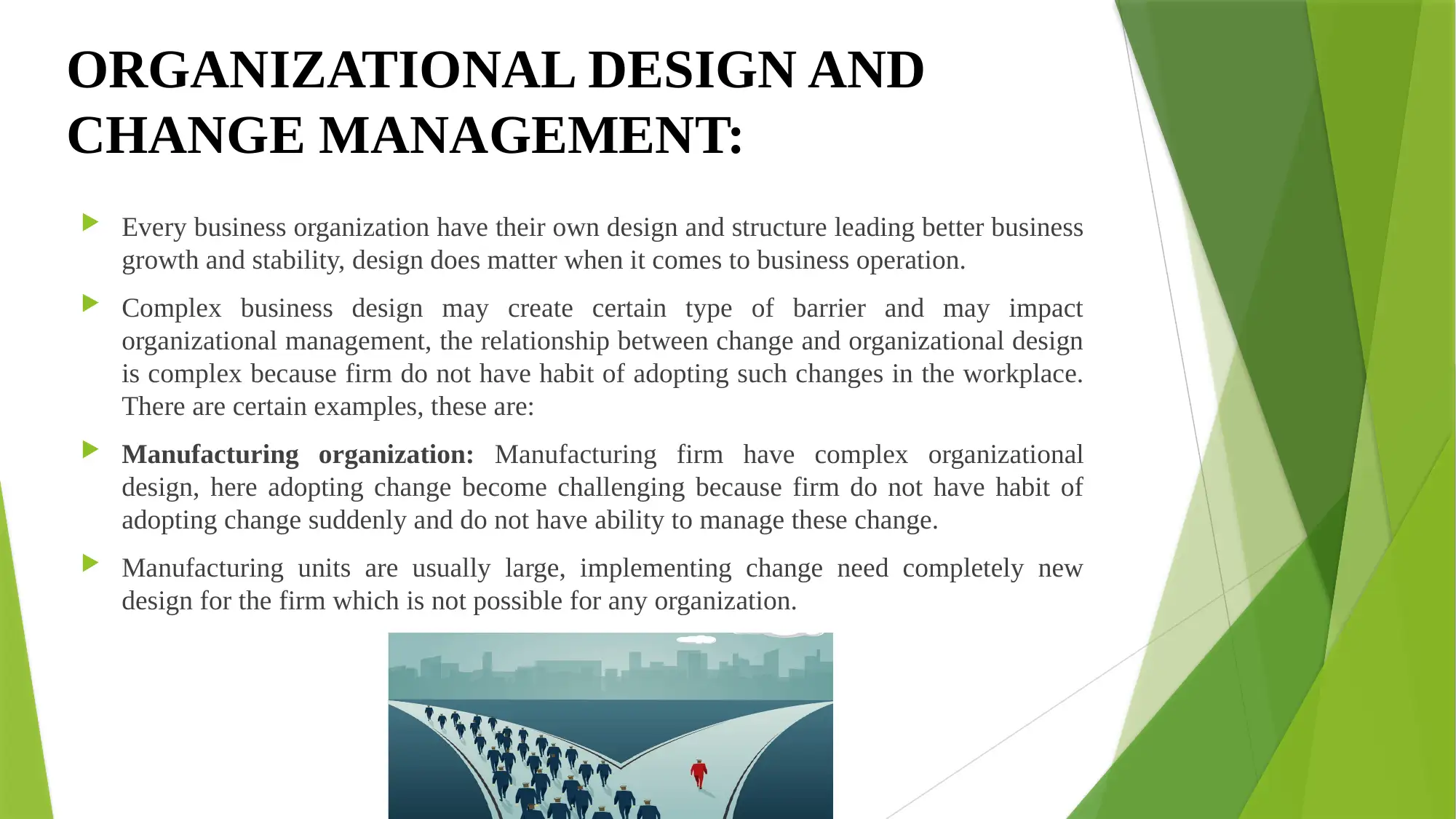
ORGANIZATIONAL DESIGN AND
CHANGE MANAGEMENT:
Every business organization have their own design and structure leading better business
growth and stability, design does matter when it comes to business operation.
Complex business design may create certain type of barrier and may impact
organizational management, the relationship between change and organizational design
is complex because firm do not have habit of adopting such changes in the workplace.
There are certain examples, these are:
Manufacturing organization: Manufacturing firm have complex organizational
design, here adopting change become challenging because firm do not have habit of
adopting change suddenly and do not have ability to manage these change.
Manufacturing units are usually large, implementing change need completely new
design for the firm which is not possible for any organization.
CHANGE MANAGEMENT:
Every business organization have their own design and structure leading better business
growth and stability, design does matter when it comes to business operation.
Complex business design may create certain type of barrier and may impact
organizational management, the relationship between change and organizational design
is complex because firm do not have habit of adopting such changes in the workplace.
There are certain examples, these are:
Manufacturing organization: Manufacturing firm have complex organizational
design, here adopting change become challenging because firm do not have habit of
adopting change suddenly and do not have ability to manage these change.
Manufacturing units are usually large, implementing change need completely new
design for the firm which is not possible for any organization.
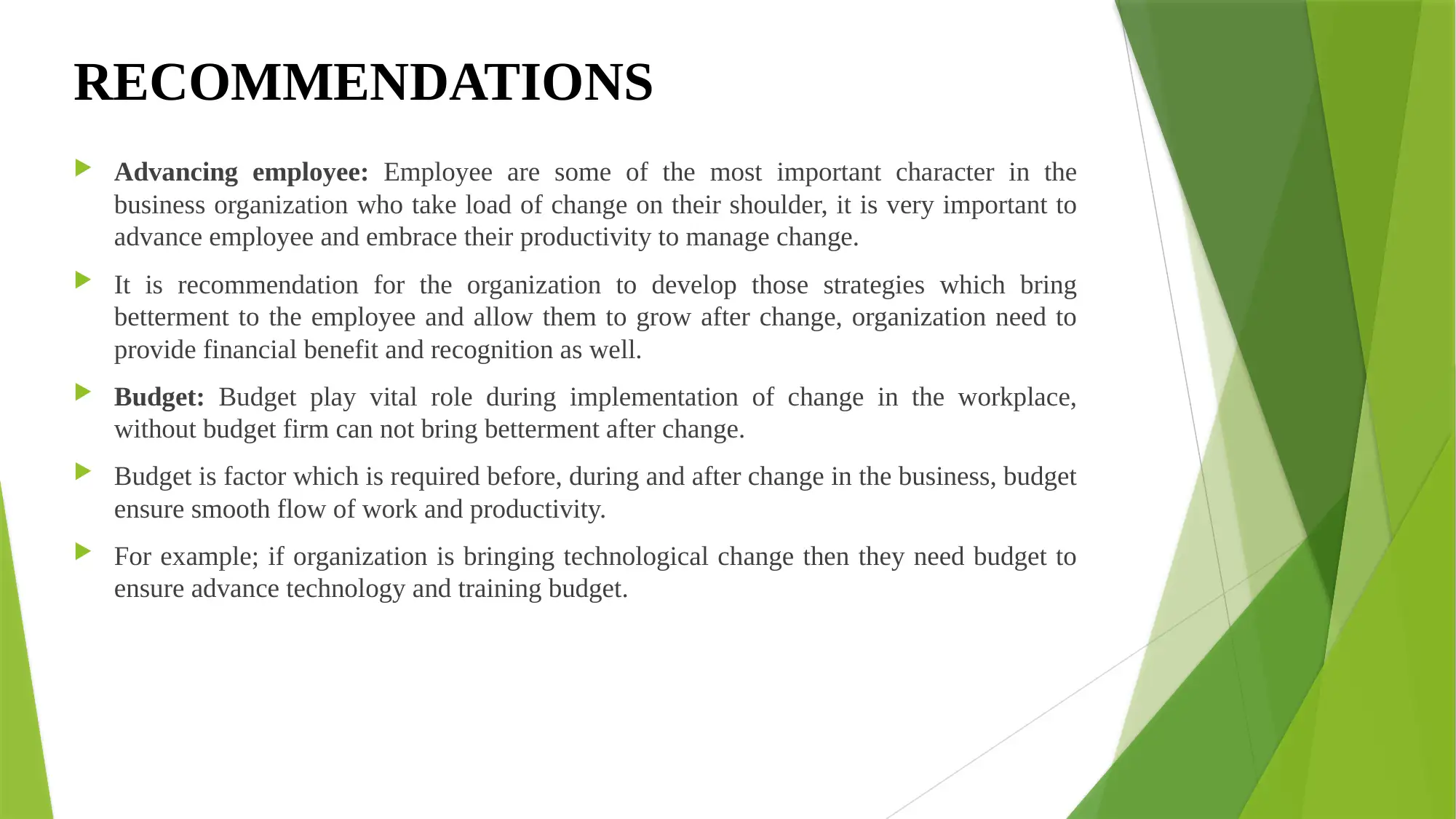
RECOMMENDATIONS
Advancing employee: Employee are some of the most important character in the
business organization who take load of change on their shoulder, it is very important to
advance employee and embrace their productivity to manage change.
It is recommendation for the organization to develop those strategies which bring
betterment to the employee and allow them to grow after change, organization need to
provide financial benefit and recognition as well.
Budget: Budget play vital role during implementation of change in the workplace,
without budget firm can not bring betterment after change.
Budget is factor which is required before, during and after change in the business, budget
ensure smooth flow of work and productivity.
For example; if organization is bringing technological change then they need budget to
ensure advance technology and training budget.
Advancing employee: Employee are some of the most important character in the
business organization who take load of change on their shoulder, it is very important to
advance employee and embrace their productivity to manage change.
It is recommendation for the organization to develop those strategies which bring
betterment to the employee and allow them to grow after change, organization need to
provide financial benefit and recognition as well.
Budget: Budget play vital role during implementation of change in the workplace,
without budget firm can not bring betterment after change.
Budget is factor which is required before, during and after change in the business, budget
ensure smooth flow of work and productivity.
For example; if organization is bringing technological change then they need budget to
ensure advance technology and training budget.
You're viewing a preview
Unlock full access by subscribing today!
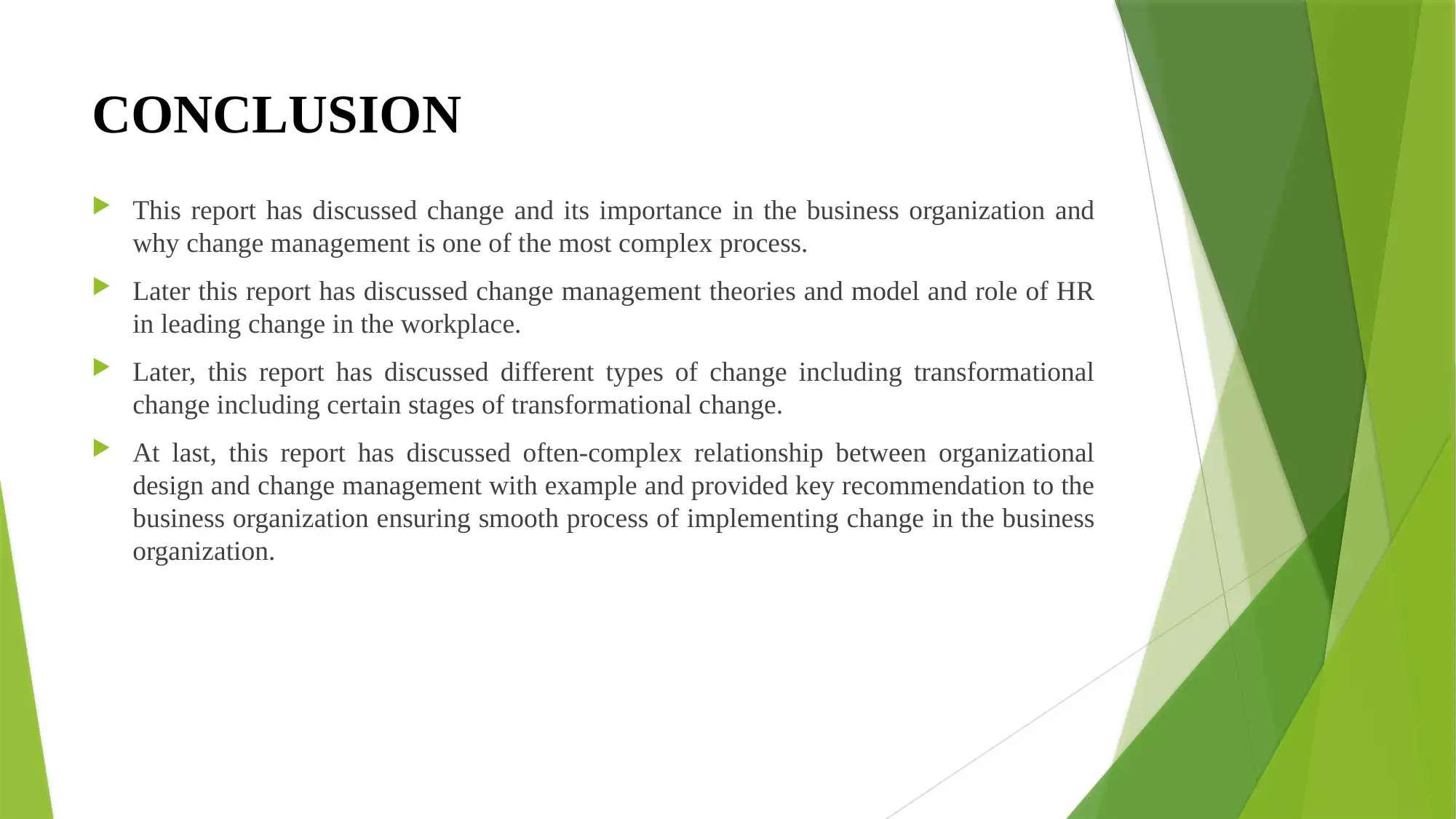
CONCLUSION
This report has discussed change and its importance in the business organization and
why change management is one of the most complex process.
Later this report has discussed change management theories and model and role of HR
in leading change in the workplace.
Later, this report has discussed different types of change including transformational
change including certain stages of transformational change.
At last, this report has discussed often-complex relationship between organizational
design and change management with example and provided key recommendation to the
business organization ensuring smooth process of implementing change in the business
organization.
This report has discussed change and its importance in the business organization and
why change management is one of the most complex process.
Later this report has discussed change management theories and model and role of HR
in leading change in the workplace.
Later, this report has discussed different types of change including transformational
change including certain stages of transformational change.
At last, this report has discussed often-complex relationship between organizational
design and change management with example and provided key recommendation to the
business organization ensuring smooth process of implementing change in the business
organization.
Paraphrase This Document
Need a fresh take? Get an instant paraphrase of this document with our AI Paraphraser
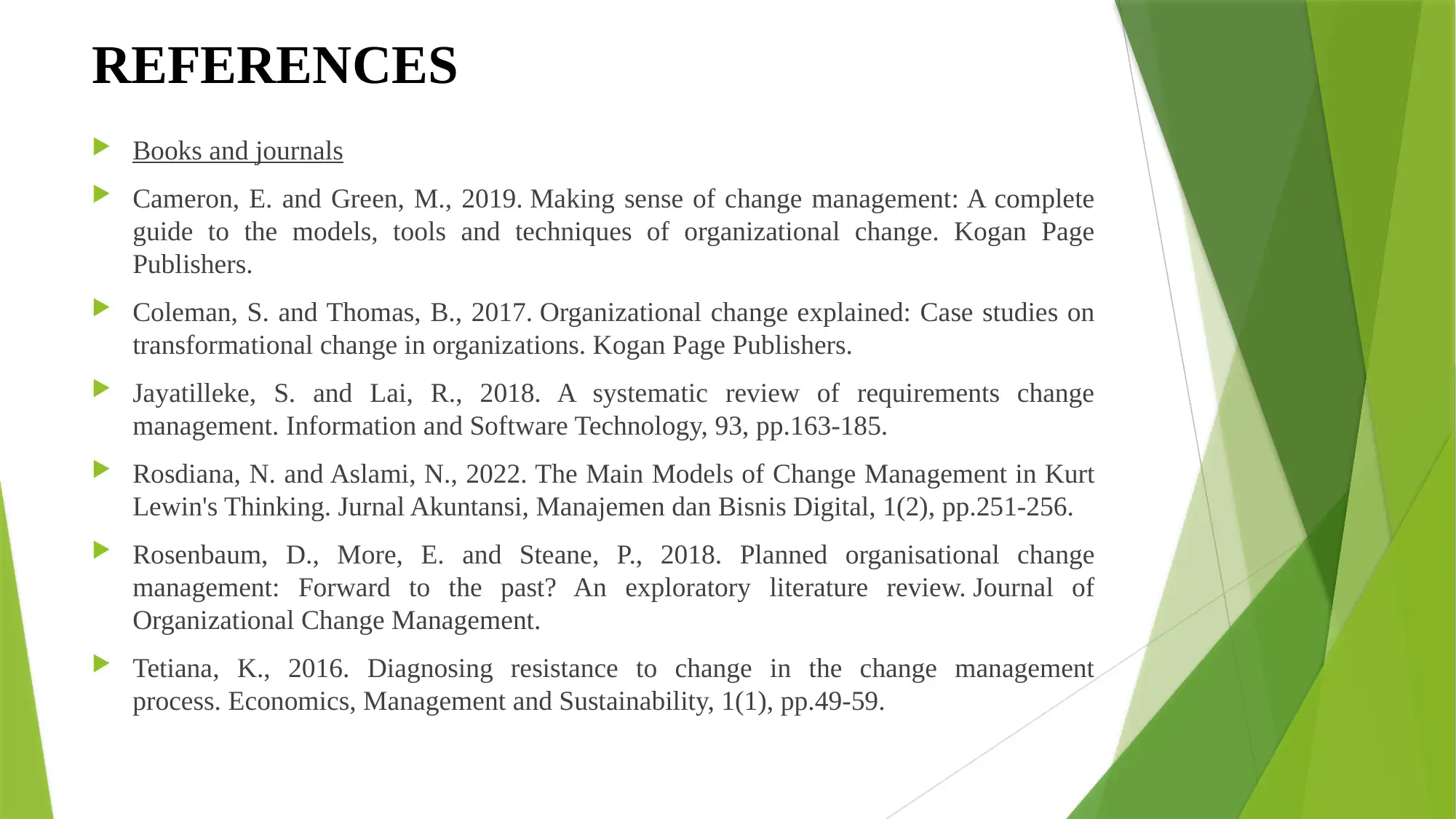
REFERENCES
Books and journals
Cameron, E. and Green, M., 2019. Making sense of change management: A complete
guide to the models, tools and techniques of organizational change. Kogan Page
Publishers.
Coleman, S. and Thomas, B., 2017. Organizational change explained: Case studies on
transformational change in organizations. Kogan Page Publishers.
Jayatilleke, S. and Lai, R., 2018. A systematic review of requirements change
management. Information and Software Technology, 93, pp.163-185.
Rosdiana, N. and Aslami, N., 2022. The Main Models of Change Management in Kurt
Lewin's Thinking. Jurnal Akuntansi, Manajemen dan Bisnis Digital, 1(2), pp.251-256.
Rosenbaum, D., More, E. and Steane, P., 2018. Planned organisational change
management: Forward to the past? An exploratory literature review. Journal of
Organizational Change Management.
Tetiana, K., 2016. Diagnosing resistance to change in the change management
process. Economics, Management and Sustainability, 1(1), pp.49-59.
Books and journals
Cameron, E. and Green, M., 2019. Making sense of change management: A complete
guide to the models, tools and techniques of organizational change. Kogan Page
Publishers.
Coleman, S. and Thomas, B., 2017. Organizational change explained: Case studies on
transformational change in organizations. Kogan Page Publishers.
Jayatilleke, S. and Lai, R., 2018. A systematic review of requirements change
management. Information and Software Technology, 93, pp.163-185.
Rosdiana, N. and Aslami, N., 2022. The Main Models of Change Management in Kurt
Lewin's Thinking. Jurnal Akuntansi, Manajemen dan Bisnis Digital, 1(2), pp.251-256.
Rosenbaum, D., More, E. and Steane, P., 2018. Planned organisational change
management: Forward to the past? An exploratory literature review. Journal of
Organizational Change Management.
Tetiana, K., 2016. Diagnosing resistance to change in the change management
process. Economics, Management and Sustainability, 1(1), pp.49-59.

You're viewing a preview
Unlock full access by subscribing today!
1 out of 15
Related Documents
Your All-in-One AI-Powered Toolkit for Academic Success.
+13062052269
info@desklib.com
Available 24*7 on WhatsApp / Email
![[object Object]](/_next/static/media/star-bottom.7253800d.svg)
Unlock your academic potential
© 2024 | Zucol Services PVT LTD | All rights reserved.





